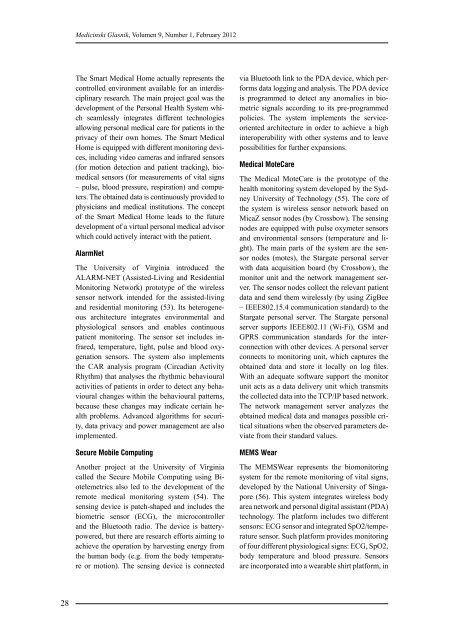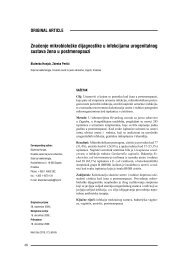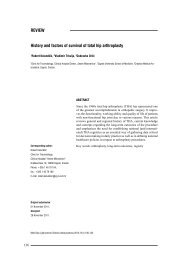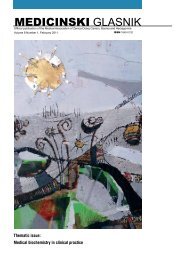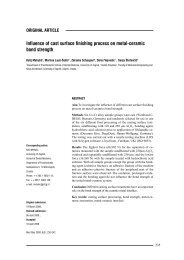MEDICINSKI GLASNIK
MEDICINSKI GLASNIK
MEDICINSKI GLASNIK
You also want an ePaper? Increase the reach of your titles
YUMPU automatically turns print PDFs into web optimized ePapers that Google loves.
28<br />
Medicinski Glasnik, Volumen 9, Number 1, February 2012<br />
The Smart Medical Home actually represents the<br />
controlled environment available for an interdisciplinary<br />
research. The main project goal was the<br />
development of the Personal Health System which<br />
seamlessly integrates different technologies<br />
allowing personal medical care for patients in the<br />
privacy of their own homes. The Smart Medical<br />
Home is equipped with different monitoring devices,<br />
including video cameras and infrared sensors<br />
(for motion detection and patient tracking), biomedical<br />
sensors (for measurements of vital signs<br />
– pulse, blood pressure, respiration) and computers.<br />
The obtained data is continuously provided to<br />
physicians and medical institutions. The concept<br />
of the Smart Medical Home leads to the future<br />
development of a virtual personal medical advisor<br />
which could actively interact with the patient.<br />
AlarmNet<br />
The University of Virginia introduced the<br />
ALARM-NET (Assisted-Living and Residential<br />
Monitoring Network) prototype of the wireless<br />
sensor network intended for the assisted-living<br />
and residential monitoring (53). Its heterogeneous<br />
architecture integrates environmental and<br />
physiological sensors and enables continuous<br />
patient monitoring. The sensor set includes infrared,<br />
temperature, light, pulse and blood oxygenation<br />
sensors. The system also implements<br />
the CAR analysis program (Circadian Activity<br />
Rhythm) that analyses the rhythmic behavioural<br />
activities of patients in order to detect any behavioural<br />
changes within the behavioural patterns,<br />
because these changes may indicate certain health<br />
problems. Advanced algorithms for security,<br />
data privacy and power management are also<br />
implemented.<br />
Secure Mobile Computing<br />
Another project at the University of Virginia<br />
called the Secure Mobile Computing using Biotelemetrics<br />
also led to the development of the<br />
remote medical monitoring system (54). The<br />
sensing device is patch-shaped and includes the<br />
biometric sensor (ECG), the microcontroller<br />
and the Bluetooth radio. The device is batterypowered,<br />
but there are research efforts aiming to<br />
achieve the operation by harvesting energy from<br />
the human body (e.g. from the body temperature<br />
or motion). The sensing device is connected<br />
via Bluetooth link to the PDA device, which performs<br />
data logging and analysis. The PDA device<br />
is programmed to detect any anomalies in biometric<br />
signals according to its pre-programmed<br />
policies. The system implements the serviceoriented<br />
architecture in order to achieve a high<br />
interoperability with other systems and to leave<br />
possibilities for further expansions.<br />
Medical MoteCare<br />
The Medical MoteCare is the prototype of the<br />
health monitoring system developed by the Sydney<br />
University of Technology (55). The core of<br />
the system is wireless sensor network based on<br />
MicaZ sensor nodes (by Crossbow). The sensing<br />
nodes are equipped with pulse oxymeter sensors<br />
and environmental sensors (temperature and light).<br />
The main parts of the system are the sensor<br />
nodes (motes), the Stargate personal server<br />
with data acquisition board (by Crossbow), the<br />
monitor unit and the network management server.<br />
The sensor nodes collect the relevant patient<br />
data and send them wirelessly (by using ZigBee<br />
– IEEE802.15.4 communication standard) to the<br />
Stargate personal server. The Stargate personal<br />
server supports IEEE802.11 (Wi-Fi), GSM and<br />
GPRS communication standards for the interconnection<br />
with other devices. A personal server<br />
connects to monitoring unit, which captures the<br />
obtained data and store it locally on log files.<br />
With an adequate software support the monitor<br />
unit acts as a data delivery unit which transmits<br />
the collected data into the TCP/IP based network.<br />
The network management server analyzes the<br />
obtained medical data and manages possible critical<br />
situations when the observed parameters deviate<br />
from their standard values.<br />
MEMS Wear<br />
The MEMSWear represents the biomonitoring<br />
system for the remote monitoring of vital signs,<br />
developed by the National University of Singapore<br />
(56). This system integrates wireless body<br />
area network and personal digital assistant (PDA)<br />
technology. The platform includes two different<br />
sensors: ECG sensor and integrated SpO2/temperature<br />
sensor. Such platform provides monitoring<br />
of four different physiological signs: ECG, SpO2,<br />
body temperature and blood pressure. Sensors<br />
are incorporated into a wearable shirt platform, in


